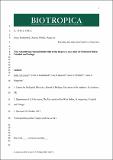Files in this item
Quantifying regional biodiversity in the tropics : a case study of freshwater fish in Trinidad and Tobago
Item metadata
| dc.contributor.author | Jones, Faith A M | |
| dc.contributor.author | Rutherford, Mike | |
| dc.contributor.author | Deacon, Amy E. | |
| dc.contributor.author | Phillip, Dawn A. T. | |
| dc.contributor.author | Magurran, Anne E. | |
| dc.date.accessioned | 2020-08-19T23:34:44Z | |
| dc.date.available | 2020-08-19T23:34:44Z | |
| dc.date.issued | 2019-08-20 | |
| dc.identifier | 259356202 | |
| dc.identifier | 4a6fa068-4c6c-4203-82c8-61c876b77017 | |
| dc.identifier | 85070931471 | |
| dc.identifier | 000482321800001 | |
| dc.identifier.citation | Jones , F A M , Rutherford , M , Deacon , A E , Phillip , D A T & Magurran , A E 2019 , ' Quantifying regional biodiversity in the tropics : a case study of freshwater fish in Trinidad and Tobago ' , Biotropica , vol. Early View . https://doi.org/10.1111/btp.12692 | en |
| dc.identifier.issn | 0006-3606 | |
| dc.identifier.other | ORCID: /0000-0002-0036-2795/work/60887666 | |
| dc.identifier.other | ORCID: /0000-0001-6571-714X/work/60888244 | |
| dc.identifier.uri | https://hdl.handle.net/10023/20489 | |
| dc.description | Funding: European Research Council (AdG BioTIME 250189 and PoC BioCHANGE 727440) (AEM). | en |
| dc.description.abstract | Extinction rates are predicted to accelerate during the Anthropocene. Quantifying and mitigating these extinctions demands robust data on distributions of species and the diversity of taxa in regional biotas. However, many assemblages, particularly those in the tropics, are poorly characterized. Targeted surveys and historical museum collections are increasingly being used to meet the urgent need for accurate information, but the extent to which these contrasting data sources support meaningful inferences about biodiversity change in regional assemblages remains unclear. Here, we seek to elucidate uncertainty surrounding regional biodiversity estimates by evaluating the performance of these alternative methods in estimating the species richness and assemblage composition of the freshwater fish of Trinidad & Tobago. We compared estimates of regional species richness derived from two freshwater fish datasets: a targeted two year survey of Trinidad & Tobago rivers and historical museum collection records submitted to The University of the West Indies Zoology Museum. Richness was estimated using rarefaction and extrapolation, and assemblage composition was benchmarked against a recent literature review. Both datasets provided similar estimates of regional freshwater fish species richness (50 and 46 species, respectively), with a large overlap (85%) in species identities. Regional species richness estimates based on survey and museum data are thus comparable, and consistent in the species they include. Our results suggest that museum collection data are a viable option for setting reliable baselines in many tropical systems, thereby widening options for meaningful monitoring and evaluation of temporal trends. | |
| dc.format.extent | 832546 | |
| dc.language.iso | eng | |
| dc.relation.ispartof | Biotropica | en |
| dc.subject | Assemblage composition | en |
| dc.subject | Museum collections | en |
| dc.subject | Species richness | en |
| dc.subject | Neotropics | en |
| dc.subject | Rarefaction | en |
| dc.subject | Extrapolation | en |
| dc.subject | QH301 Biology | en |
| dc.subject | SH Aquaculture. Fisheries. Angling | en |
| dc.subject | DAS | en |
| dc.subject | SDG 15 - Life on Land | en |
| dc.subject.lcc | QH301 | en |
| dc.subject.lcc | SH | en |
| dc.title | Quantifying regional biodiversity in the tropics : a case study of freshwater fish in Trinidad and Tobago | en |
| dc.type | Journal article | en |
| dc.contributor.sponsor | European Research Council | en |
| dc.contributor.sponsor | European Research Council | en |
| dc.contributor.institution | University of St Andrews. School of Biology | en |
| dc.contributor.institution | University of St Andrews. Centre for Biological Diversity | en |
| dc.contributor.institution | University of St Andrews. Marine Alliance for Science & Technology Scotland | en |
| dc.contributor.institution | University of St Andrews. Scottish Oceans Institute | en |
| dc.contributor.institution | University of St Andrews. Institute of Behavioural and Neural Sciences | en |
| dc.contributor.institution | University of St Andrews. St Andrews Sustainability Institute | en |
| dc.contributor.institution | University of St Andrews. Fish Behaviour and Biodiversity Research Group | en |
| dc.contributor.institution | University of St Andrews. Centre for Research into Ecological & Environmental Modelling | en |
| dc.identifier.doi | 10.1111/btp.12692 | |
| dc.description.status | Peer reviewed | en |
| dc.date.embargoedUntil | 2020-08-20 | |
| dc.identifier.grantnumber | 250189 | en |
| dc.identifier.grantnumber | 727440 | en |
This item appears in the following Collection(s)
Items in the St Andrews Research Repository are protected by copyright, with all rights reserved, unless otherwise indicated.

